From the Shelf of Doom: Special Hobby Gloster E.28/39 “Pioneer” – RAF/100
As a result of collaboration between jet engine inventor Frank Whittle and W.George Carter, Chief Designer at Gloster Aircraft, the company was chosen on February 3, 1940 to create and produce the first British jet-powered aircraft.
Built to specification E.28/39, the contract stated: “The primary object of this aeroplane will be to flight test the engine installation, but the design will be based on requirements for a fixed-gun interceptor fighter as far as the limitations of size and weight imposed by the power unit permit.”
With an estimated engine thrust of 1,200 lbs., maximum speed was expected to be 380 m.p.h. With Whittle and Carter cooperating closely in the initial design stages, it was decided to create a small, low wing monoplane with a tricycle gear, with the engine mounted behind the pilot's cockpit. Construction of two E.28/39 prototypes began in late April 1940.
The E.28/39 had an 81-gallon gas tank between the engine and the cockpit, giving the pilot excellent visibility from his forward position. The engine, known as the W.1, eventually produced 860 lbs. thrust, which meant that the armament of four .303 caliber machine guns and their associated ammunition had to be left out.
The first prototype, W4041, was completed in mid-April 1941. Powered by a test engine known as the W.1X, which was made from spare parts and did not have the performance of the flight-rated W.1, the airplane was set for a series of test-runs on the grass airfield at the Brocklands factory, with Flight Lieutenant P.E.G. Sayer, Gloster's Chief Test Pilot at the controls on April 7, 1941. Sayer found that it needed 10,000rpm of the 13,000 rpm allowed to move the airplane, with poor acceleration. Permitted r.p.m. was increased to 16,000 the next day, and during the second of two test runs the E.28/39 “hopped” three times, each hop being about 300-900feet at an altitude of around 6 feet.
The E.28/39 was moved to Cranwell airfield - which had a hard-surface runway - for its flight tests, where the W.1 engine was installed. On May 15, prospects for a first flight didn't look good, due to adverse weather. However, by 1900 the weather had improved sufficiently that Sayer prepared for takeoff at 1945. He ran the engine to 15,500 r.p.m., holding position with the brakes. After a run of about 1800 feet, Sayer felt sufficient control response to attempt lift-off, and the E.28/39 climbed into the early evening sky. Sayer found the control responses light and responsive during the 17-minute first flight.
Fourteen test flights were carried out over the next 13 days, with the E.28/39 being flown to 25,000 feet and an indicated airspeed of 300 m.p.h.
Seven months elapsed from this first series of flights before the airplane was given the new W.1A engine and began flying from Edgehill airfield.. During the fifth flight of the second series, engine trouble appeared which took ten days to resolve. On March 24, 1942, real trouble happened. Sayer was climbing through 30,000 feet when he experienced serious engine vibration. Throttling back, he returned to Edgehill, where it was discovered a turbine blade had failed. On June 6, at 30,000 feet during a speed run, Sayer experienced a flame-out, which turned out to be due to a broken engine bearing. With a new engine installed by August, Sayer again experienced engine failure on September 27, making it back to the airfield with such a bounce that the port wingtip touched ground and was crumpled.
Sayer was killed three weeks later in a Typhoon, and his place was taken by Michael Daunt, who returned the E.28/39 to the air on November 6, 1942, after which it was transferred to Farnborough, where service pilots took over the test program.
The second E.28/39, W4046, was finally equipped with a Power Jets W.2B engine and flew for the first time on March 1, 1943, with John Grierson at the controls. Grierson made 12fligyts in the following two weeks and on April 17, 1943 made the first British cross-country jet flight, taking the second prototype from Edgehill to Hatfield to demonstrate it for Winston Churchill.
W4046 was delivered to Farnborough where it was fitted with a new W.2B providing 1,526 lbs. thrust. On July 30, 1943, Squadron Leader D. Davie was on a high altitude test when the ailerons jammed. Davies became the first pilot to successfully bail out of a jet aircraft, leaving W4046 at 33,000 feet. W4041 was fitted with a W.2B/500 engine providing 1,700 lbs. thrust in the meantime. On July 6, the high-speed “E” wing was finally installed. In final series of contractor tests, Daunt established the top speed of the E.28/39 at 466 m.p.h. The airplane was handed over to the RAF that September for a final series of tests ending in June 1944.
On April 28, 1946, the E.28/39 was installed at the Science Museum in Kensington, London, where it has remained on permanent public display.
Special Hobby released this kit (and one other of the later version ED) in the late 1990s, and it is the only 1/48 scale kit of the E.28/39 ever released. Frog made a 1/72 kit in the 1970s. The kit is still available, at least on-line.
The kit is limited-run, and therefore needs cleanup of the limited number of parts. Fit is overall OK, with a need for putty on the main seams. The parts count is low. The cockpit is very simple, but the original was too.
I realized after it was constructed that Special Hobby had designed the landing gear too long, being the condition it would be in during flight with no weight on the gear. Overall, the model should sit about 1/4 inch lower than it does.
Getting sufficient weight in the nose is difficult. Once I had it assembled and on its gear, I found that all the weights I had put in were insufficient, so I filled the nose intake area right up, which gave enough weight to keep it on the nose gear. I made an intake cover from Evergreen sheet plastic to hide the weights.
After pre-shading the model, I painted the lower surfaces British Trainer Yellow, using Xtracrylix. The upper colors are Xtracrylix RAF Dark Earth and Dark Green, applied freehand. After I finished the model, I noted from several photos of the actual airplane that Special Hobby's painting instructions had been incorrect for the proper camouflage pattern. The Propagteam Decals went on without difficulty. No stencil decals are provided.
This is a simple kit of an historically-important airplane. This review is 10 years delayed because I put the half-completed model in a box during a move and forgot about it until I recently rediscovered the box and opened it up. The model is simple enough that it would be a good first limited-run kit.
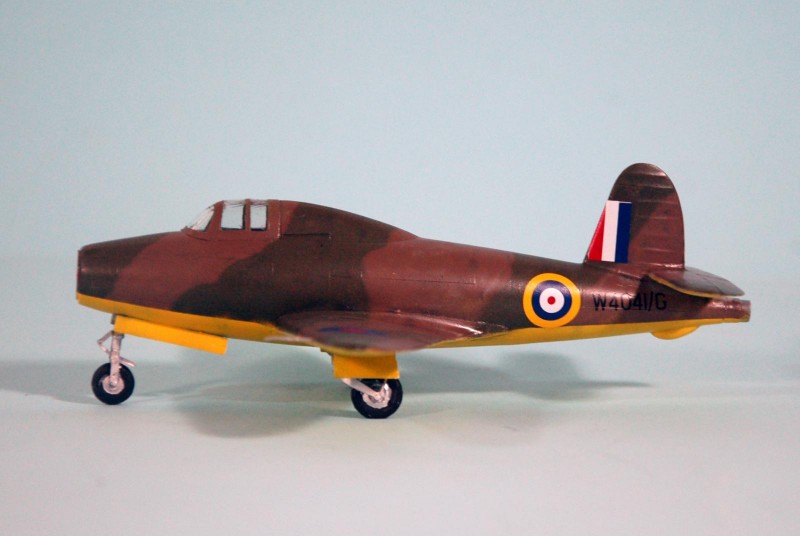

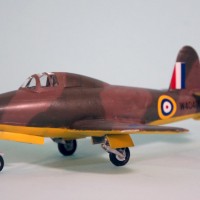
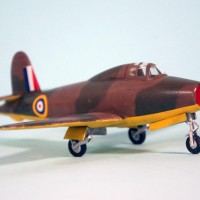
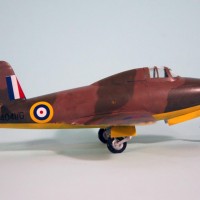
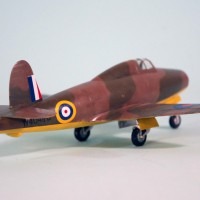
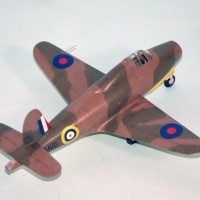
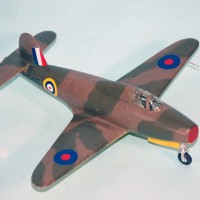
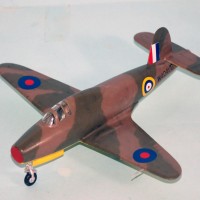
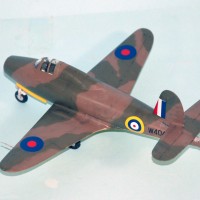
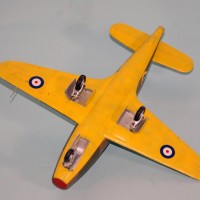
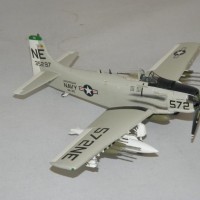
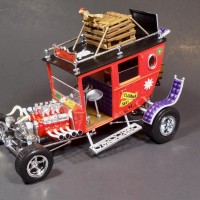
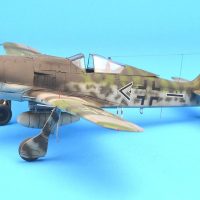
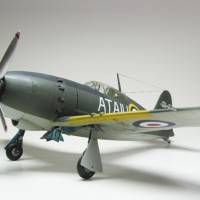
A great bit of history, nice!
Now there’s a thing you don’t see often. As you say, a historically important aircraft that blazed the trail for the Allies’ first operational jet, the ‘Meteor’.
To be honest with you David … this is the second one I see.
Very nice piece of history and for sure a very good conversational topic.
Nice clean work.
Lovely looking little beast. A nice comparison would be to park it next to a 40 years later F-15
Fantastic Tom! Another important historical step in the history of the RAF - great that it made it off the shelf! Doesn't look like it should have been there in the first place and I am very glad you found it again! I love the camo - entirely accurate but looks somehow out of place on that plane! Thanks for posting!
Nice Tom - kinda reminds me of a tadpole in shape!